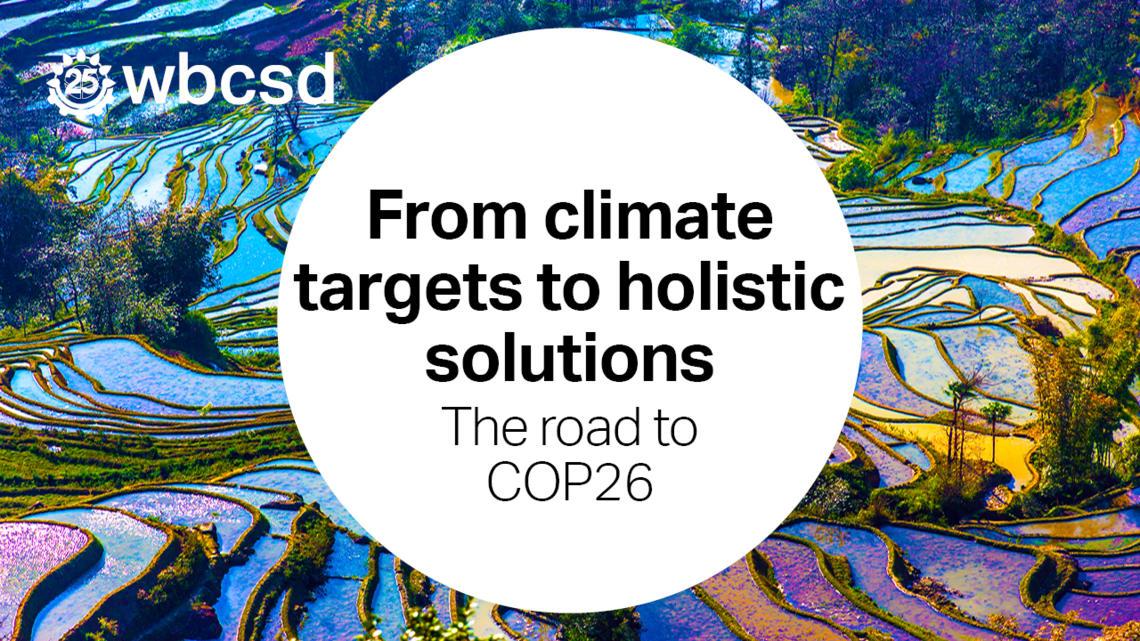From Climate Targets to Holistic Solutions
The road to COP26 will be all about implementation

From climate targets to holistic solutions
We've come a long way since the 2015 signing of the Paris Agreement.
On the one hand, we have not made the progress needed:
- Global emissions have continued to rise,
- And the unity of governments shown in Paris has since been tested and disrupted.
On the other hand, it’s fair to say that we have come a long way:
- Since the 2018 IPCC report, the target of 1.5 degrees to halve emissions is now the norm,
- Many companies have set net zero targets to be achieved by no later than 2050,
- And the recommendations of the Task Force on Climate-related Financial Disclosures (TCFD) have been developed.
I remember the days in 2015, when WBCSD was leading work which was called the Low-Carbon Technology Partnership Initiative (LCTPi), in the run up to COP21. Eventually, more than 235 companies and 50 partners came together to work on nine big business solutions to reduce emissions, pushing policy makers to be bold. Business was present at COP21, stating “We have solutions. If you give us a clear policy track, preferably carbon pricing, then we will accelerate”.
The Paris Agreement – combined with the ever-clearer science and mounting impacts of natural disasters – has given business that clear signal and sense of direction it needed and requested. Many companies are now adjusting their strategies to the transformations that a net zero pathway will bring.
Moreover, the COVID pandemic has only made clearer that collectively we were ill-prepared for the kind of shock that a global event can produce. And we all know that the impact of climate change can be much bigger. We have seen even more companies, from the energy and food sectors to the automotive and tech sectors, setting ambitious targets in spite of the pandemic disruptions. COVID-19 has also taught us – in a hard way – that all elements are interconnected: there is no other option than thinking through solutions and their implementation in a holistic way for climate, nature, health and social equity to achieve true system transformation.
Despite lackluster progress in the COPs after Paris, recently we have seen governments really stepping up as well, including Canada, China, Japan and South Korea, and of course the Green Deal in Europe. Depending on events unfolding, there is now even strong hope that the United States will return to lead the way.
Next up: making it real – the road to COP26
To turn all commitments and targets into reality, with COP26 as one of the upcoming key milestones, we need two things:
- Companies should create operating plans to implement the solutions needed towards halving emissions within this decade. This does not only require CEO leadership within companies, but also collaboration in sectors and across value chains.
- Companies need to transparently disclose their targets and plans, and report progress towards those. The recommendations of the Task Force on Climate-related Financial Disclosures (TCFD) and ESG developments are important to implement.
The COP26 Private Finance Strategy describes the role that TCFD can play to ensure that every financial decision takes climate change into account. Mark Carney, who’s leading that work as the Finance Adviser to the Prime Minister for COP26 and UN Special Envoy for Climate Action and Finance, commented at the TCFD Summit in October: “We’re working to make sure you will have the information to take into account climate risk and very importantly climate opportunities”.
As I highlighted during that same TCFD Summit, “we must create a capital market that rewards more sustainable businesses with a lower cost of capital and thus allocates more financial capital to the critical systems transitions ahead of us.”
Moving beyond targets – WBCSD’s support to lead and act
However, while all of this bodes well for COP26 and the level of ambition that we can bring there, we need more to double down, since we are nowhere near enough bending the curve on emissions globally. We have all been talking about transformation and setting targets, but it is time to move beyond ambition and targets and make net zero real, within the next decade.
The big question on the business table is: what is the fundamental change that business can implement? What would we, if we could shape the agenda now, bring to the COP26 eleven months from now as the solutions from business? And that is what makes COP26 different from COP21 in Paris in 2015: we are not moving to the adoption of a global agreement; COP26 will be about implementation.
In response, we have now calibrated all WBCSD programs to align with net-zero and the 1.5 aligned ambition. In April 2020, we launched SOS 1.5 to replace LCTPi as a coherent cross-cutting framework for all WBCSD activities on climate action. SOS 1.5 develops guidance for individual companies to accelerate their net-zero journey, as well as work to accelerate collective action that is required by sectors and value chains. WBCSD has made the 1.5 degrees target part of our updated membership criteria. To my knowledge, we are the first business association in the world that have included net zero no later than 2050 as a criterion for companies to be a member.
Also, new elements of work are being added: like Agriculture 1.5, and the link to nature-based solutions about which we have just launched the new report “Mapping nature-based solutions and natural climate solutions”, helping companies to accelerate consistent and credible actions that are positive for both climate and nature. Nature-based solutions can help to deliver up to 37% of the solutions to achieve the Paris Agreement, and have the potential to support the nature-loss challenges while being good for business and people. It is great to see that also the COP26 leadership has realized this, visible through climate change and nature being the two key focus areas of the upcoming climate conference.
To conclude – this is not just about climate but systemic transformation. Nor is it just about business. Business has a major role to play and a strong voice, which we should use. But we really should also use COP26 to build renewed collaboration with governments and the investor community, as well as with civil society, because only together will we get implementation to scale.
Should you wish to take part in our collective call to action, we have put together the following video to galvanize ambition and showcase the voice of business as a force for good for climate.
So today, we should briefly “celebrate” the progress that has been made since and thanks to the Paris Agreement. However, thereafter we should continue to focus on making the necessary transition real and fast in 2021.

